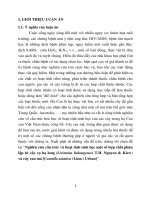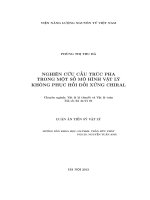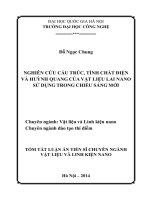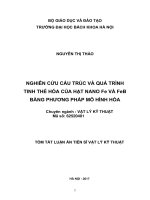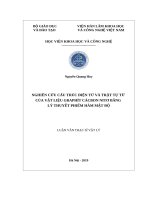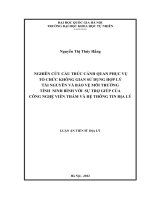(Luận án tiến sĩ) nghiên cứu cấu trúc và tính thơm của một số cluster boron bằng phương pháp hóa học lượng tử
Bạn đang xem bản rút gọn của tài liệu. Xem và tải ngay bản đầy đủ của tài liệu tại đây (5.57 MB, 171 trang )
MINISTRY OF EDUCATION AND TRAINING
QUY NHON UNIVERSITY
DUONG VAN LONG
A QUANTUM CHEMICAL RESEACH OF STRUCTURE
AND AROMATICITY OF SOME BORON CLUSTERS
DOCTORAL DISSERTATION: Theoretical and Physical Chemistry
MINISTRY OF EDUCATION AND TRAINING
QUY NHON UNIVERSITY
DUONG VAN LONG
A QUANTUM CHEMICAL RESEACH OF
STRUCTURE AND AROMATICITY OF SOME
BORON CLUSTERS
Major: Theoretical and Physical Chemistry
Code No: 9440119
Reviewer 1: Prof. Dr. Nguyen Ngoc Ha
Reviewer 2: Prof. Dr. Tran Thai Hoa
Reviewer 3: Prof. Dr. Duong Tuan Quang
Supervisors:
1.
Assoc. Prof. Dr. Nguyen Phi Hung
2.
Prof. Dr. Nguyen Minh Tho
BINH DINH – 2023
DECLARATION
This dissertation was written on the basis of research work carried out at Quy Nhon
University, Binh Dinh province, under the supervision of Professor Nguyen Minh
Tho and Associate Professor Nguyen Phi Hung.
I hereby declare that the results presented are original from my own research work.
Most of them were already published in peer-reviewed international journals.
For the use of the results from joint papers, I received permissions from my coauthors.
Quy Nhon Binh Dinh
06 November 2023
Author
Duong Van Long
ACKNOWLEDGEMENTS
I would like to express my sincere gratitude to professors and colleagues at Quy
Nhon University, my family and friends who have accompanied me throughout the long
years of pursuing a doctoral program.
In particular, I would like to express sincere thanks to the professors and faculty
staffs of the Department of Chemistry, Faculty of Natural Sciences and Postgraduate
Training Office of Quy Nhon University for their support, understanding and for creating
conditions for me to overcome obstacles caused by the COVID-19 pandemic.
I would like to express my deepest gratitude to my supervisors, Profs. Nguyen Minh
Tho and Nguyen Phi Hung, for their invaluable guidance and support throughout my
academic journey. Prof. Tho and Prof. Hung have been my scientific mentor since the
beginning of my academic career, and I am truly grateful for their unwavering support and
encouragement. They provided me with the foundation and skills necessary to succeed in
my academic pursuits. Their expertise and mentorship have been instrumental in shaping
my research and helping me achieve my academic goals. I am honoured to have the
opportunity to work under the guidance of both Professors Tho and Hung and I am forever
grateful for their constant support.
Thank you, Nguyen Ngoc Tri, Phan Dang Cam Tu, My Phuong Pham Ho and
Nguyen Minh Tam, for sharing and accompanying me on my academic path.
I would like to express my debt to my parents for their unconditional love and
support. Their guidance sacrifices and encouragement have been instrumental in shaping
me into the person I am today. Thank you, Mom and Dad, for everything.
I would also like to thank my wife and my little son for their love and
encouragement. My wife has been a constant source of inspiration and support. She has
stood by my side through thick and thin, even during long nights when she had/has to listen
to the sound of clattering keyboards while I was, and I am, working on my academic
projects. I cannot thank her enough for her patience, understanding and foremost love. And
my little son, you are the driving force for me to move forward, to achieve what we have
now and in the future.
I dedicate this thesis, my great achievement, to my family, and hope to continue
making them proud.
Table of Contents
List of symbols and notations ..........................................................................................
List of Figures
i
iii
................................................................................................................
ix
List of Tables ..................................................................................................................
GENERAL INTRODUCTION .......................................................................................
1
A. Research introduction......................................................................................
1
B. Objectives and scope of the research ..............................................................
2
C. Novelty and scientific significance .................................................................
2
Chapter 1.
DISSERTATION OVERVIEW ......................................................
4
1.1.
Overview of the research .....................................................................
4
1.2.
Objectives of the research ...................................................................
6
1.3.
Research content ..................................................................................
6
1.4.
Research methodology ........................................................................
6
1.4.1. Search for lower-lying isomers .......................................................
6
1.4.2. ELF – The electron localization function .......................................
7
1.4.3.
Ring current maps ...........................................................................
8
1.4.4. Bond order and net atomic charge ................................................
10
Chapter 2.
THEORETICAL
BACKGROUNDS
COMPUTATIONAL METHODS ....................................................................
2.1.
AND
11
Theoretical backgrounds of computational quantum chemistry .......
11
2.1.1.
Schrödinger equation ....................................................................
11
2.1.2.
The Born–Oppenheimer Approximation ......................................
11
2.1.3. Ab initio computational method ...................................................
13
2.1.4.
14
The Hartree-Fock Method ............................................................
2.1.5. Density Functional Theory.......................................................... 15
2.1.6. Benchmarking the functional and basis set in DFT.....................19
2.1.7. Post-Hartree-Fock methods......................................................... 21
2.2.
Aromaticity models in boron clusters............................................... 24
2.2.1. The Hückel and Baird rules......................................................... 24
2.2.2. Ribbon aromaticity...................................................................... 31
2.2.3. Disk aromaticity.......................................................................... 40
2.2.4. Hollow cylinder model................................................................ 46
Chapter 3. RESULTS AND DISCUSSION.................................................. 50
q
3.1.
The Hückel rule and the ribbon model: The cases of B2Si3 and
p
B3Si2 clusters............................................................................................. 50
3.1.1. Motivation for the study.............................................................. 50
3.1.2. The benchmarking tests............................................................... 53
3.1.3. Ribbon aromaticity model versus the Hückel electron count......60
3.1.4. Concluding remarks.................................................................... 72
3.2.
The disk aromaticity on the quasi-planar boron cluster B700/2-
...............................73
3.2.1. Motivation of the study............................................................... 74
3.2.2.
The quasi-planar B700/2-
....................................................................... 76
3.2.3. Disk model and electron count rule............................................. 78
3.2.4. Concluding remarks.................................................................... 82
3.3.
Binary boron lithium clusters B12Lin with n = 1–14: the disk-cone
model for the B12Li4 cluster......................................................................... 82
3.3.1. Motivation of the study............................................................... 82
3.3.2. The growth pattern of B12Lin with n = 0 – 14..............................84
3.3.3.
Relative stabilities of clusters .......................................................
9
3.3.4.
Chemical Bonding ........................................................................
9
3.3.5.
A mixed cone-disk model .............................................................
9
3.3.6.
Concluding remarks ....................................................................
10
3.4.B14FeLi2 and the hollow cylinder model .........................................
10
3.4.1.
Motivation of the study ............................................................
10
3.4.2.
Stability of B14FeLi2 and its potential applications ....................
10
3.4.3.
Concluding remarks ....................................................................
11
Chapter 4.
GENERAL CONCLUSIONS AND FUTURE DIRECTIONS .. 112
4.1. General Conclusions ........................................................................
112
4.2. Future Directions .............................................................................
114
LIST OF PUBLICATIONS CONTRIBUTING TO THE DISSERTATION ............
116
REFERENCES ............................................................................................................
117
Appendix .....................................................................................................................
133
List of symbols and notations
2D
Two dimensional
3D
Three dimensional
ACID
Anisotropy of the induced current density
ADE
Adiabatic detachment energy
AdNDP
Adaptive Natural Density Partitioning
AO
Atomic orbital
ASBO
Average of the sum of the bond orders
CASSCF
Complete Active Space Self-Consistent Field
CBS
Complete basis set
CC
Coupled cluster
CCSD
Coupled cluster including singles and doubles
CCSD(T)
CCSD with a perturbative triples correction
CI
Configuration Interaction
CMO
Canonical Molecular Orbital
CTOCD-DZ2
Continuous transformation of the origin of the current density diamagnetic zero, with shifting the origin toward the nearest nucleus
DFT
Density functional theory
DM
Disk model
DR
Double ring
ELF
Electron localization function
GA
Genetic algorithm
GGA
Generalized gradient approximation
GTO
Gaussian-type orbitals
HCM
Hollow cylinder model
HF
Hartree-Fock
HLG
Frontier orbital (HOMO – LUMO) energy gap
HOMO
Highest Occupied Molecular Orbital
i
IEv
IR-UV2CI
LCAO
Vertical ionization energy
LDA
Resonant infrared-ultraviolet two-color ionization spectroscopy
LUMO
Linear combination of atomic orbitals
MBPT
Local density approximation
MEGA
Lowest Unoccupied Molecular Orbital
meta-GGA
Many-body perturbation theory
MO
Mexican Enhanced Genetic Algorithm
MPn
Meta-generalized gradient approximation
MRCI
Molecular orbital
NAC
n-order Møller-Plesset perturbation method
NICS
Multireference Configuration Interaction
PES
Calculated net atomic charged
PSM
Nuclear independent chemical shift
QP
Photoelectron spectroscopy
RMS
Phenomenological shell model
RSS
Quasi-planar
SBO
Root mean square
SOMO
Residual sum of squares
SPION
Sum of bond orders
STO
Singly Occupied Molecular Orbital
TD-DFT
Superparamagnetic iron oxide nanoparticles
TEAv
Slater-type orbitals
UV
Time dependent density functional theory method
UV-Vis
Vertical two-electron affinity
VASP
Ultraviolet
VDE
Ultraviolet-Visible
Vienna ab initio simulation package (VASP)
Vertical detachment energy
ii
List of Figures
Figure 1.1. Illustration of a genetic algorithm (GA) procedure ([31]).......................7
Figure 1.2. The current density maps of π electron contribution of a) C4H4 and
b)
C6H6 plotted by both SYSMOIC and ACID packages.............................................. 9
Figure 2.1. The π molecular orbitals of benzene according to the Hückel theory. The
dashed line represent the energy of an isolated p orbital, and all orbitals below this
line are bonding. All orbitals above it are antibonding............................................ 29
Figure 2.2. MO energy diagrams of C4H4 (in both singlet and triplet states), C6H6,
C8H8 (in both singlet and triplet states), and C10H8. The blue/red labels indicate the
aromatic/antiaromatic species................................................................................. 29
Figure 2.3. Calculated curves as a function of size n for (a) adiabatic detachment
-
energies of Li2BnH2 (n = 6–22) ribbon clusters, and (b) Ionization energies of
Li2BnH2 (n = 6–22) ([88])........................................................................................ 31
6 4
2-
-
Figure 2.4. The electron configuration π σ of the ribbons B10H2 and B11H2 ......32
Figure 2.5. The potential-energy function of the one-dimensional model...............33
Figure 2.6. A comparison between the
,
and the distance of between the two
2-
most distant B atoms of B14H2 .............................................................................. 35
2-
2-
Figure 2.7. a) The ribbon structure of B14H2 . b) ELFσl plot for B14H2 , and c) ELFπ
2-
(yellow basins) and ELFσd (green basins) are plotted simultaneously for B 14H2 . .. 36
2-
Figure 2.8 a) The ribbon structure of the singlet B12H2 ; b) ELFσl
plot for the
2-
singlet B12H2 , and c) ELFπ (yellow basins) and ELFσd (green basins) are plotted
2-
simultaneously for the singlet B12H2 ..................................................................... 38
2-
Figure 2.9. a) The ribbon structure of the triplet B12H2 . b) ELFσl plot for the triplet
2-
B12H2 . c)
ELFπ
(yellow basins) and
ELFσd
(green basins) are plotted
2-
simultaneously for the triplet B12H2 . d) and e) are the ELFπ and ELFσd plotted
2-
simultaneously for the triplet B12H2 from and
Figure 2.10. The Bessel functions
with
electrons, respectively............39
44
= 0, 1, and 2............................................................................................................................................
iii
Figure 2.11. Symmetries of some wavefunctions in the disk model. The two colours
red and blue indicate the opposite signs of the wave functions. ...............................
45
Figure 2.12. Hollow cylinder model. The hollow cylinder's height is L, radius is R,
inner radius is R0, and outer radius is R1. Particle's movement is limited from R0 to
R1, with R0 = R – r, R1 = R + r where r is called the active radius of the hollow
cylinder. .....................................................................................................................
Figure 2.13. The variation of function
with
46
in equation (2.85) according to
48
= 0.5 and =±1 or =±2. ...........................................................................
-
Figure 3.1. Photoelectron spectra of B 2Si3 clusters recorded with 266 nm photons [93].
........................................................................................................................... 51
Figure 3.2. (a) Comparison of IR-UV2CI spectrum of B 2Si3 with IR absorption
spectra calculated for the low-energy structures 3.2a-e [94]. (b) Relaxed 3.2.a
isomer was obtained using the CCSD method or different DFT functionals [95].... 51
Figure 3.3. An illustration of clusters with 2 π electrons and 2 σ delocalized
electrons. ...................................................................................................................
53
q
Figure 3.4. Shapes of low-lying isomers of B 2Si3 clusters with q going from -2 to
+2. Geometry optimizations are carried out using the TPSSh/6-311+G(d) level of
theory. Relative energies (kcal/mol) are computed using three different methods and
will be elucidated in the text. ....................................................................................
54
p
Figure 3.5. Shapes of low-lying isomers of B 3Si2 clusters with p going from -3 to
+1. Geometry optimizations are carried out using the TPSSh/6-311+G(d) level of
theory. Relative energies (kcal/mol) are computed using three different methods and
will be elucidated in the text. ....................................................................................
55
q
Figure 3.6. A pathway illustrating the evolution leading to the B 2Si3 from the
3-
-
trianionic ribbon II.B3Si2 in which a B unit is replaced by an isovalent Si atom at
two different positions leading to two isomeric types, namely ribbon (R) and Hückel
(H). ............................................................................................................................
3-
61
2-
Figure 3.7. Delocalized π and delocalized σ CMOs of a) II.B3Si2 , b) I.B2Si3 and
2-
c) II.B2Si3 isomers. The atom positions are labelled by a, b, c, d and e. ................
iv
62
p
Figure 3.8. a-f) Ribbon structures of B3Si2 . i) Bond lengths (Å) and bond
order
(given in brackets) by blue numbers and net atomic charges are given by red
numbers. ELF isosurfaces of ELF = 0.8 under ii) top view and iii) side view. iv)
Electron configurations. Energy levels with green arrow(s) belong
to π and σ
delocalized CMOs whereas energy levels with grey arrows point out localized
CMOs...................................................................................................................... 65
Figure 3.9. The representation of the self-locking phenomenon in the ribbon
-
3-
-
-
structures of B7H2 , B8H2, B9H2 , B9H2Li2 , and B10H2 . B-B bond lengths are
assigned by colour range from red to blue: 1.50 Å to 1.80 Å. Nimag
indicates the
number of negative frequencies of the structure...................................................... 66
-
Figure 3.10. The lowest-lying isomers of B3Si2Li2 shares the same B3Si2
3-
ribbon
+
frame and two decorative Li ions in different positions. Relative energies are
calculated at TPSSh/6-311+G(d) + ZPE level of theory.......................................... 67
3-
2-
Figure 3.11. ELFπ maps for II.B3Si2 and I.B2Si3 ................................................ 68
q
Figure 3.12. a-f) Nanoribbon structures of B2Si3 . i) Bond lengths (Å) and
bond
order (given in braces) are given by blue numbers and net charges are given by red
numbers. ELF isosurfaces of ELF = 0.8 under ii) top view and iii) side view. iv)
Electron configurations. Energy levels with green arrow(s) belong
to π and σ
delocalized CMOs while energy levels with grey arrows point out localized CMOs.
................................................................................................................................... 69
q
Figure 3.13. a-e) The Hückel type of B2Si3 i) Bond lengths (Å) and bond
order (given in braces) are given by blue numbers and net charges are given by red
numbers. ELF isosurfaces of ELF = 0.8 under ii) top view and iii) side view. iv)
Electron configurations. Energy levels with green arrow(s) belong
to π and σ
delocalized CMOs while energy levels with grey arrows point out localized CMOs.
70
Figure 3.14. A quasi-planar structure consisting of 70 boron atoms was generated
using the topological leapfrog algorithm starting from an initial B16 form with 13
vertices (the atom with yellow glow)...................................................................... 75
v
Figure 3.15. The selection of energetically favourable isomers of B70. The
abbreviation "3D" refers to three-dimensional isomers, while "QP" denotes quasiplanar isomers. The numbers, represented by "n = 1, 2, 3, …," indicate the relative
energy order of each 3D or QP isomer.................................................................... 77
2-
Figure 3.16. Correspondence between the calculated π-MOs of the B70 dianion
with the energy levels of the disk model................................................................. 79
2-
Figure 3.17. Correspondence between the π-MOs of B70 with the non-degenerate
energy levels of the disk aromaticity model............................................................ 81
2-
Figure 3.18. Total magnetic current density maps of a) the B70 dianion, and b) the
triplet QP.1 B70. Vectors are plotted on a surface at 1 Å above the framework of the
structure with the external magnetic field perpendicular to the molecular plane
directed towards the reader...................................................................................... 81
Figure 3.19. Geometry, point group and relative energy (kcal/mol, (U)CCSD(T)/ccPVTZ + ZPE) of B12Lin with n = 0 – 6. Relative energies at TPSSh/6-311+G(d) +
ZPE are given in parentheses. TPSSh/6-311+G(d) optimized geometries are used. 85
Figure 3.20. Geometry, point group and relative energy (kcal/mol, (U)CCSD(T)/ccPVTZ + ZPE) of B12Lin with n = 7 – 10. Relative energies at TPSSh/6-311+G(d) +
ZPE are given in parentheses. TPSSh/6-311+G(d) optimized geometries are used. 87
Figure 3.21. Geometry, point group and relative energy (kcal/mol, (U)CCSD(T)/ccPVTZ + ZPE) of B12Lin with n = 11 – 14. Relative energies at TPSSh/6-311+G(d)
+ ZPE are given in parentheses. TPSSh/6-311+G(d) optimized geometries are used.
89
Figure 3.22. a) Binding energy per atom; b) Average of sum of bond orders (ASBO)
values; c) HOMO – LUMO gaps; and d) Dissociation energy (left y-axis) and
second-order energy difference variation (right y-axis) of the binary B12Lin (n = 0–
14 clusters).............................................................................................................. 92
Figure 3.23. MO energy diagrams of the 4C, 8A and 14C-Th isomers. The line
levels are full occupied MOs, and the dash line levels are unoccupied CMOs. The
vi
brown, red, blue, green, and black colour points out the S, P, D, F and G subshells,
correspondingly....................................................................................................... 93
Figure 3.24. The ELF map of 14C-Th. The red and yellow basins indicate the B and
Li positions, respectively. The conventional covalent basins are coloured by green
while the lone pair basins coloured by purple......................................................... 94
Figure 3.25. The ELF map of 8A. The red and yellow basins indicate the B and Li
positions, respectively. The conventional covalent basins are coloured by green
while the lone pair basins coloured by purple......................................................... 95
Figure 3.26. Optimized adsorption configurations of a) 8A-8H2, b) 8A-16H2, c) 8A24H2, d) 8A-32H2, and e) 8A-40H2 (wB97XD/6-311++G(2d,2p)).........................96
Figure 3.27. The lowest-energy structures of the isoelectronic B13Li and B12Li4
clusters.................................................................................................................... 97
Figure 3.28. Valence MOs and LUMO of the B13Li cluster assigned within the
circular disk model. H stands for HOMO and L stands for LUMO.........................98
Figure 3.29. The total current density maps of a) B13Li and b) B12Li4 and the c)
π
and d) σ current density maps of B13Li. External magnetic field vector is
present by
the blue arrow. Vectors are plotted on a surface having the cone shape
at 1 Å inside
B-cone framework................................................................................................... 99
2-
Figure 3.30. 2σ and 3σσ and 3σ-orbitals of B20 and B13Li under the top view and side
view.
100
Figure 3.31. The lowest-lying isomer of B14Fe [135]............................................ 102
Figure 3.32. Optimized structures of lower-energy isomers of B14FeLi2;
E
values are in kcal/mol from TPSSh/def2-TZVP energies with ZPE corrections. . .103
Figure 3.33. Formation of MOs of B14FeLi2 from MOs of singlet B14 skeleton and a
contribution from d-AO of Fe atom. Some MOs of the singlet B14 skeleton are
assigned by hollow cylinder model....................................................................... 104
Figure 3.34. ACID map of Li2FeB14 from a) top view and b) side view................106
vii
Figure 3.35. ACID isosurface (isovalue = 0.05) of three valence MOs sets of
B14FeLi2 on the view from Li-Fe-Li axis (Oz axis) including a) localized set, b)
tangential set and c) radial set................................................................................ 107
Figure 3.36. Predicted electronic absorption spectrum of the teetotum B14FeLi2
(TPSSh/def2-TZVP).............................................................................................. 108
Figure 3.37. Optimized structure of the designed [Li-B14Fe-Li]-[B14Fe]-[Li-B14FeLi] wire.................................................................................................................. 110
Figure 3.38. Optimized structures of (I) B28Fe2Li2Mg, (II) B42Fe3Li2Mg2, (III)
B56Fe4Li2Mg3, and (IV) B70Fe4Mg4Li2 nanowires in antiprism and prism forms. . 110
viii
List of Tables
Table 2.1. First three roots (
the integer constant
,
) of the Bessel functions of the first kind, with
ranging from 0 to 4............................................................. 44
Table 3.1. Deviations of single-point (U)CCSD(T)/CBS total energies of the
considered structures computed using geometries optimized by different DFT
levels....................................................................................................................... 57
-
Table 3.2. Comparison of two PES peaks of B2Si3 ([93]) to calculate VDEs and
ADEs (eV) using different functionals with 6-311+G(d) basis set and
-
-
CCSD(T)/aug-cc-pVTZ for both anionic isomers I.B2Si3 and II.B2Si3 .................58
Table 3.3. Comparison of IR-UV2CI spectra of B2Si3 (ref. [94]) with harmonic
vibrational frequencies calculated at the DFT/6-311+G(d) and CCSD(T)/aug-ccpVTZ levels............................................................................................................. 58
Table 3.4 Summary of the aromatic characters of the species considered. The
abbreviations: R = ribbon, H = Hückel, S = strong, W = weak, A = aromatic, AA =
antiaromatic, SA = semi-aromatic, TA = triplet aromatic.......................................73
ix
GENERAL INTRODUCTION
A. Research introduction
Nearly six decades have passed since the definition of the term cluster was
formally conceived when F. A. Cotton, in 1964, first generalized a working
definition of “metal atom cluster” as “a finite group of metal atoms which are held
together mainly, or at least to a significant extent, by bonds directly between the
metal atoms, even though some nonmetal atoms may also be intimately associated
with the cluster” [1]. Ever since, experimental and theoretical studies of clusters has
flourished and the atomic clusters has emerged as a multidisciplinary scientific
field.
The cluster science is primarily concerned with finding the stable structures
of a group of atoms and then explaining the stability of those structures, along with
elucidating their characteristic physicochemical properties and the potential
applications. Along the way of rationalizing the thermodynamic stability, the
concept of aromaticity gradually emerged as a topic closely associated with cluster
science. Although aromaticity was, and remains, a fundamental concept in modern
chemistry, it is actually not a well-defined concept [2–5] that comes from the
existence of several qualitative and even quantitative models that in the meantime
support and oppose to each other. The most famous of these models is the Hückel
model [6–8] which was originally conceived for the planar hydrocarbons. For an
appropriate application of the Hückel model, we need to solve the secular equation
for each specific structure to determine the exact number of electrons involved, but
this requirement seems to have been forgotten, and only the qualitative (4n + 2)
counting rule is remembered and used not only for planar molecules in circular
form, but also for non-planar and other three-dimensional structures. The
convenience of the (4n + 2) electron counting rule has caused it to be abused to the
point that the essence and origin of the rule have often been forgotten and led to
1
